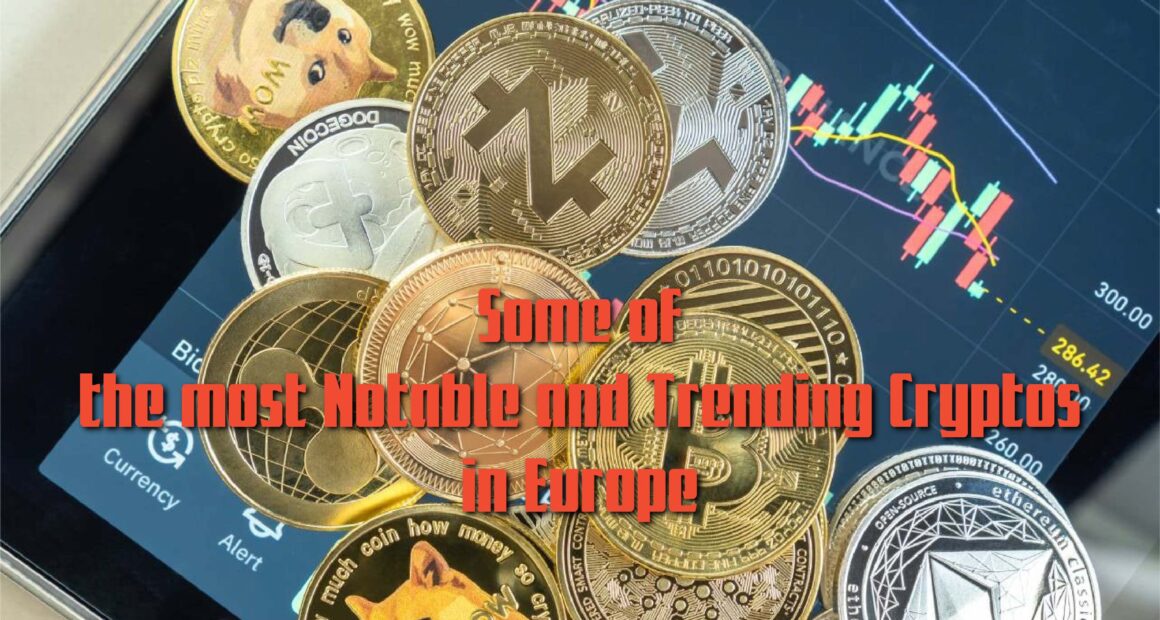As of late 2023 and early 2024, several cryptocurrencies are gaining significant traction in Europe, but the trends often vary by country and sector (DeFi, NFTs, Web3, etc.). However, some of the most notable and trending cryptos in Europe currently include:
1. Bitcoin (BTC)
- Dominance: Bitcoin continues to be the most well-known and widely held cryptocurrency globally, including in Europe. Institutional interest and adoption of Bitcoin as a store of value continue to grow, with many European countries (like Switzerland, Germany, and France) seeing increased usage in both investment and payment sectors.
- Adoption: Bitcoin adoption in Europe has been supported by major platforms and services like Bitstamp, Binance, and Kraken, along with the rise of Bitcoin-focused ETFs.
2. Ethereum (ETH)
- Smart Contracts and DeFi: Ethereum remains one of the most popular platforms in Europe, especially in the decentralized finance (DeFi) sector. The shift to Ethereum 2.0 (Proof of Stake) has further solidified its dominance.
- Integration: Many European startups and enterprises are building on Ethereum, contributing to its growth. ETH is also a favorite for NFTs and decentralized applications (dApps).
3. Cardano (ADA)
- Development in Europe: Cardano has gained significant attention in Europe, particularly in countries like Switzerland and Germany. It is considered a more sustainable alternative to Ethereum and is particularly appealing due to its focus on academic research, scalability, and sustainability.
- Partnerships: Cardano has forged several partnerships in Africa but has also made headway in European markets due to its emphasis on a robust regulatory framework.
4. Polkadot (DOT)
- European Origin: Polkadot was created by Gavin Wood, one of Ethereum’s co-founders, and it has garnered strong support in Europe. The project aims to enable different blockchains to interoperate, making it an attractive solution for developers and institutions seeking cross-chain compatibility.
- Adoption: It has gained traction in the DeFi and interoperability sectors.
5. Solana (SOL)
- Growth and Innovation: Solana has been one of the fastest-growing blockchains and is gaining popularity in Europe, especially for developers building decentralized apps (dApps) and DeFi platforms. Its low fees and fast transaction speeds are big selling points.
- Ecosystem: Solana’s ecosystem has been growing with European projects building on its blockchain.
6. Chainlink (LINK)
- Oracles: Chainlink, a decentralized oracle network, has been one of the most trending cryptos, particularly in the DeFi space, and Europe has been one of its strong adoption regions. Chainlink provides real-world data to smart contracts, which is essential for a wide range of decentralized applications.
- Partnerships: It has established partnerships with many European financial institutions and developers.
7. Ripple (XRP)
- Regulatory Focus: While facing regulatory scrutiny in the U.S., Ripple has seen continued interest in Europe, especially for cross-border payments and remittances. Ripple’s technology is being used by several European financial institutions for faster, cheaper international payments.
- Adoption: The Ripple network’s use case is especially popular among banks and enterprises in Europe looking to enhance international payment infrastructure.
8. The Graph (GRT)
- Data Indexing: The Graph, a decentralized indexing protocol for querying data for blockchains, has been growing in popularity across Europe as more DeFi protocols and dApps look for scalable and efficient data solutions.
9. Uniswap (UNI)
- DeFi and DEXs: As decentralized exchanges (DEXs) continue to rise, Uniswap, as one of the most popular DEX platforms, remains popular across Europe, especially in the growing DeFi sector.
10. Decentraland (MANA) and The Sandbox (SAND)
- NFTs and Metaverse: Both Decentraland and The Sandbox, which are platforms focused on virtual worlds and NFTs, have significant interest in Europe, particularly in the creative industries and entertainment sectors.
Emerging Trends:
- CBDCs (Central Bank Digital Currencies): While not traditional cryptocurrencies, the European Central Bank (ECB) has been actively researching and experimenting with a digital euro. As central banks around the world explore digital currencies, this is an area of growing interest and innovation in Europe.
- Sustainability Projects: Cryptos focused on energy efficiency and environmental sustainability (e.g., Chia (XCH)) are also starting to make waves, particularly in countries like Germany, which has a strong green energy agenda.
Regulatory Landscape:
- EU Regulations: The European Union’s MiCA (Markets in Crypto-Assets) regulation, expected to be fully implemented by 2024, will provide clearer guidelines on crypto regulations across Europe, potentially affecting how some cryptocurrencies trend in the region.
Conclusion:
Bitcoin, Ethereum, and Cardano are likely the most prominent cryptocurrencies in Europe right now, followed by emerging projects like Polkadot and Solana, which have been gaining traction due to their unique technological offerings. Crypto adoption in Europe continues to be driven by institutional investment, regulatory developments, and the growth of DeFi, NFTs, and the metaverse.
Please Wait










